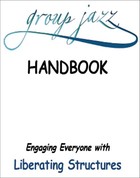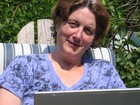How We Learn and How to Change
Use Conversations for Collaborative Reflection about Complex Adaptive Systems
Why is jazz such a compelling art form? There’s the excitement of improvisation according to a few basic rules and the fact that the musicians really tune into one another. That’s why Jazz is so good. That’s what we need to do in our work lives: we need to have the kinds of group experiences that allow us to produce things that are better in that moment. And, when we are no longer in that environment, we can still conjure up part of that feeling and use it in order to be productive.
NETTING IT OUT
Every once in a while, I meet an extraordinary person who is generous enough to tell me her story and to share the experiences that shaped her thinking. My path has crossed with Lisa Kimball’s a few times in the past, but, when we re-met at the BIF-8 conference, we decided to spend a bit more time together.
This is an interview in which I simply ask Lisa Kimball to tell the story about the trajectory of her career to-date. The particular areas of interest for me—and the things I asked about—were:
- Her discovery of the importance of experiential collaborative learning in work with children, teachers, and business executives.
- The importance of designing learning environments and interaction structures that promote whole group discussion and reflection.
- Her discovery of the core competencies that distinguish super-performing executives from average executives, including their ability to interact with complex systems and their preferred approach to problem-solving: engage with the whole system.
- Her very early work with online communities (before the Internet) as the co-founder of the longest continuous online community engaged in strategic conversations—The Meta Network, now in its 30th year.
- Her mastery of, and fascination with, structures for designing effective group meetings—not just for off-site retreats, but for embedding these structures in how we do work when we’re in our offices interacting with people on a day-to-day basis.
- Her generosity in documenting the best of these “Liberating Structures” to share freely with anyone who would like to learn and practice them through her free, online book: Engaging Everyone with Liberating Structures.
- Her commitment to transfer the knowledge of how to change conversations as the best way to change organizations without needing to rely on a consultant or other outside expert in organizational development.
- The results that one of her institutions—the Plexus Institute—has achieved in healthcare through the use of some of these liberating structures.
RANDOM WALK: COLLABORATIVE LEARNING FROM KIDS TO TEACHERS TO EXECS
Lisa, your work is fascinating to me. You’ve moved from education to management development, to collaborative technologies, to complexity theory. You’ve helped many people bring about change in complex systems. What's your background? How do you know what you know?
Lisa Kimball: In the past number of years, I’ve been interested in issues related to complexity science, and my favorite one is retrospective coherence, which means that I could make up a story that all makes perfect sense, but, of course, it was really the typical “random walk.”
I went to Sarah Lawrence College in the late 1960s—it was wonderfully eclectic. I graduated in 1970. We were all going to pick some institution to change the world from, so education was mine. So I started out in education and moved into designing learning environments.
Interest in How People Learn
I started out teaching in experimental curriculum programs. I got a chance to be a pilot teacher for an incredible program designed by Jerome Bruner and others at Harvard at that time, called, at that time: “Man: a Course of Study,” later to be called “People: A Course of Study.” It was an anthropology program for Middle School. And it was fantastic! It was really about what I’ve now learned is experiential learning/collaborative learning. I got immersed. It taught me a lot about what it takes for people to have insights—even if they were 9-year olds. I got very interested in how people thought and learned.
Learning Is Experiential
What does it take for people to have insights?
I think they have to have a situation in which they’re led to inquire. There was a famous paper by David Hawkins in 1965, called “Messing About in Science.” The idea was that you took kids down to a stream and you gather things in jars, and that causes people to say: “why is that doing that?” “Why is that color in here and there’s another color over there?” That’s being led to inquire, which is what scientists actually do, rather than the way that science is often presented in school. Students think scientists are the people who know all the answers to science tests, when actually scientists are people who are looking for answers to things that nobody knows the answers to yet, which is a very different dynamic. That’s what gets people excited and motivated and wanting to think about things.
How Does the Brain Work?
After learning about experiential learning in the context with kids, I was interested in trying to figure out how that connected to what anyone knew about how the brain worked and cognition. So I kept going back to school and learning more about cognitive development. I got a PhD in educational psychology and cognition and learning. I was trying to find out theoretically what people knew about how the brain developed and how people learned things.
What I learned turned out to be very aligned with the experience that I had teaching with kids and then, later, working with teachers. I kept escalating and moving up the scale because there were so many constraints on how people thought about schools. There were limitations on what you could do as a classroom teacher. So I got into teaching teachers.

Lisa Kimball has collected many of the structures that work well in whole system meetings into a handbook which is available free of charge at www.groupjazz.com.
Designing Learning Environments
I began working in Teacher Development; I figured maybe that’s the place where you can make a difference. I worked with the Children’s Museum in Boston and with Wheelock College’s Teacher Resource Center.
That happened to be an era when people were experimenting with helping teachers literally make their own furniture and learning tools because, in order to do experiential learning, you needed to have completely different workspaces. We had a great Resource Center where we’d go and get stuff that people were throwing away. One company would be throwing away pieces of rubber with holes cut out of them, and another company was throwing away the holes they’d cut out. These things would make fantastic classroom materials. You could make experiential math materials and so forth. Among other things we used were tri-wall cardboard and cable cores that telephone companies used, to make little tables and desks.
Empowering People to Use Tools to Create Learning Environments. In teaching teachers, most of whom were women, how to use power tools to make furniture, it had the same kind of empowering feeling that I noticed later when we started teaching people how to use PCs and that kind of technology. It felt very similar.
Why Is Group Discovery Important to Learning?
When you worked with kids and then teachers—were you focused on group learning and its impact on individual cognition all along?
It definitely had a group valence. What I kept feeling was that how people learned the most was interacting with the world and with other people. So, you get a group of 4th, 5th, and 6th grade kids together all looking at things and talking about them. One of my pet stories is from when I was supervising a student teacher in a classroom. A kid had brought in a bird’s nest. And she had it on her desk, and kids were gathered around and saying, “look at that, what’s that? It’s a string. How does it hold together?” They were doing what a group of people will do and asking questions. And what a good teacher will do is say, “well, how could we find that out?” But, instead, the teacher, clapped her hands and said, “OK, put that away, it’s time for science!”
(Download the PDF for the entire article.)
How to Contact Lisa Kimball:
lisa@groupjazz.com
http://www.groupjazz.com
C: 202.344.5930
F: 202.237.1547
Sign in to download the full article
0 comments
Be the first one to comment.




